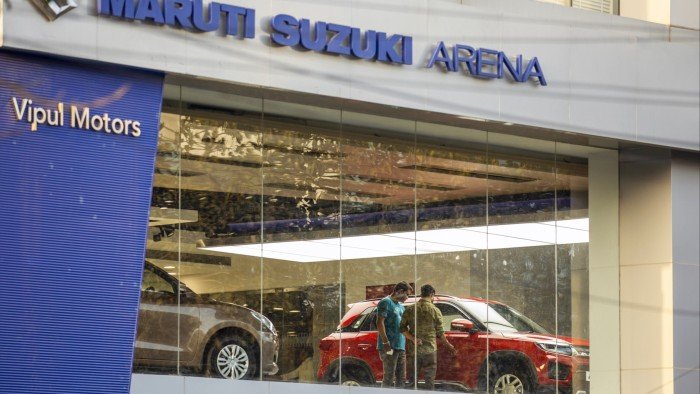Maruti Suzuki, India’s largest carmaker, aims to reclaim dominance over the world’s third-biggest car market by targeting “the next 1bn Indians”, in an ambitious bet on the buying power of the country’s aspiring middle class.
The company aims to double Indian production to 4mn vehicles a year by 2030 — many of them for export — and take its domestic market share back above 50 per cent. Its share of the Indian market has slipped to 41 per cent over the past five years as competitors benefited from the rising popularity of sport utility vehicles among wealthy Indians.
Kenichi Ayukawa, an executive vice-president, said only 200mn to 300mn affluent Indians had been in the company’s sights as potential customers over the past 40 years and horizons needed to widen.
“India has 1.4bn people. We have to look to the next 1bn . . . and how we’re going to approach those people,” he said in an interview with the Financial Times.
Ayukawa, who was chief executive of Maruti Suzuki for nine years until 2022, said the company was working “to approach rural areas, find out what they are expecting and how we are going to encourage the rural economy; that’s going to be the future customers for us”.
Kenichi Ayukawa says Maruti Suzuki needs to widen its target market © Sajjad Hussain/AFP via Getty Images
The Japanese executive’s remarks represent an optimistic market-size view for cars in the world’s most populous country, with motorbikes still outnumbering them and average incomes low.
One way Maruti, the publicly listed Indian subsidiary of Suzuki, is tackling the problem is by building infrastructure to turn methane-rich cow dung into biogas that can be cheap, clean fuel for rural citizens unable to afford electric vehicles.
Suzuki, which owns 58 per cent of the Indian carmaker, plans to spend ¥1.2tn ($8.5bn) to increase production and introduce new models in India over five years, but analysts say its bid to claw back lost market share will be challenged by increasingly fierce competition and tightening domestic emissions and safety regulations. In its 2024 fiscal year, its car sales in India were flat at 1.8mn units.
Some analysts said Suzuki’s vision remained constrained in the short term by limits on the size of India’s middle class and the work on road and urban infrastructure still needed to accommodate a shift from motorcycles to passenger cars.
“The Indian market is becoming very challenging to grow,” said Ravi Bhatia, president and director of Jato Dynamics India. “A few people have lots of money, a lot of people don’t have a lot of money, and urban areas are becoming jam-packed, with nowhere to drive or park cars.”
Suzuki’s India focus has proved attractive to investors as turmoil strikes the world’s top two auto markets, with intense competition in China and President Donald Trump’s tariffs on US automotive imports unleashing chaos for most major carmakers. By comparison, Suzuki has escaped relatively unscathed with net income soaring 31 per cent to a record high of ¥416bn ($2.84bn) in the 2024 fiscal year.
But Julie Boote, analyst at Pelham Smithers, said foreign carmakers such as Hyundai, Renault and Volkswagen were looking to India as “the new China”.
“Competition is getting increasingly fierce — it will be really difficult for Suzuki to retain its market share,” she said.
At the same time, sales of higher-priced SUVs — favoured by wealthy Indians who have weathered the slowdown relatively well — have this year outstripped the smaller cars that dominate Suzuki’s portfolio.
Maruti Suzuki has been outfoxed on SUVs, suited to India’s potholed roads, by local rivals Tata Motors and Mahindra, and has been playing catch-up through its Grand Vitara and Brezza models. Suzuki executives believe more releases are still needed to close the gap.
A Maruti Suzuki Jimny SUV © Pradeep Gaur/SOPA Images/LightRocket via Getty Images
To address long-standing production constraints and portfolio gaps, Suzuki started production in February at a factory in Haryana state near Delhi, its fourth site in India, and is expanding operations in Gujarat to build electric vehicles and batteries, where it has also trailed the competition.
Another notable new entrant has been Suzuki’s alliance partner Toyota, the world’s largest carmaker whose Indian sales have grown to 300,000 units in three years. It owns almost 5 per cent of Suzuki, which shares its knowledge of India in return for access to Toyota’s technology.
As Suzuki and others pour investment into India, their ambitions risk rubbing against consumers’ wallets. A recent report by Blume Ventures, a Mumbai-based venture capital firm, identified the “consuming class” in the country at 140mn people, with a further 300mn citizens in the “emerging aspirant class”.
Recommended
“The aspirations and the investments being done by the automakers here are quite huge,” said Vivek Kumar, a Hyderabad-based automotive analyst with GlobalData. “But the majority of Indian consumers are very price-sensitive.”
Chief executive Toshihiro Suzuki admitted during a full-year earnings call last week that boosting sales in India would “not be simple” and the market would face supply chain challenges caused by US tariffs and simmering tensions with Pakistan over Kashmir.
If incomes across India do manage to grow, Suzuki may be better placed than others to meet their needs. It has a reputation of keeping a tight rein on costs and holds 70 per cent of dealerships in rural areas, according to Goldman Sachs.
“They have a strong presence where demand should be structurally strong. Fundamentally, rural area market growth should give them decent upside for market share,” said Kota Yuzawa, analyst at the US bank.
But those strengths will not be enough, as Maruti Suzuki also needs to come up with the right cars for India’s changing tastes.
“The reason Suzuki still rules the car park in India is that it has the best distribution and the best aftersales service,” said Jato’s Bhatia. “But the product offerings will have to evolve.”


